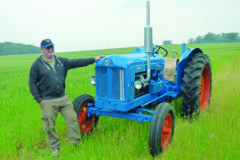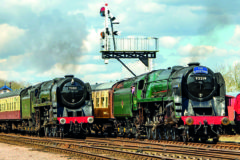Classic vehicle models
Posted by Chris Graham on 14th January 2021
Graham Dungworth shares some winter-themed photographs of his amazing dioramas, featuring classic vehicle models from yesteryear.

Classic vehicle models: On a bright morning following a snowy night, the driver of this Mercedes-Benz Unimog, NFW,172V (Lincoln, 1980) pauses to chat to a neighbour. This is a model by Corgi, with a lot of extra detail added. The working suspension on this old toy is a miniature engineering masterpiece.
Being an avid collector of classic vehicle models, I often wonder what is it that makes us so nostalgic about old vehicles? Could it be memories of some long-lost company that used to operate them, or perhaps the quirks and foibles of the vehicles themselves? Perhaps it might simply be that they offer us a chance to re-live times when the roads were quieter, when drivers seemed to be more courteous and when most people actually used their mirrors and direction indicators!
Whatever it is, thank goodness there are so many classic vehicles still going strong to keep us all happy. Whether our main interest lies with cars, commercial vehicles, coaches or buses, more often than not there will be an easily accessible rally that we can visit to admire the vehicles, and speak to their owners.
Model enthusiasts
The same range of interests can also be applied to enthusiasts of classic vehicle models. Broadly speaking, they fall into three categories; collectors, restorers and modellers. All are equally valid, but they’re really quite different. Collectors like to buy their models in mint, boxed condition wherever possible, and usually have a theme to their collection. It could be the model manufacturer, such as Dinky or Corgi. It could be models of the same make of vehicle, such as Leyland, AEC or Foden or, maybe buses from one particular operator’s fleet.
Restorers like to find old, possibly rare, models or toys and restore them to the condition they were in when they first left the model maker’s production line. Restorers will always pay particular attention to the exact colour schemes used by the model manufacturer. Collectors and restorers tend to use purpose-built cabinets in which to display their models, specifically designed to keep them free from dust (the models, not the collectors!)
Modellers try to make their classic vehicle models model look as much like the real thing as possible. This, invariably, means stripping the model to its component parts, modifying or even making new parts if necessary, possibly weathering (like my model of a Unimog), and sometimes re-spraying. One thing’s certain, though, a lot of fine detailing will always be required.
Then, of course, there’s me! I fall into the latter category. In a way, I’m a bit like a railway modeller; after finishing a model I then make a diorama against which I can photograph it. The settings and miniature figures can sometimes take as much time and effort as the models themselves. Come on, it’s my hobby so I can do what I like!
Fine-weather photos
Of course, I’m not unique in this; there are lots of other modellers who photograph their models in miniature landscapes, and very effective they look, too. But I’ve noticed that in most photographs – mine included – it’s usually summer or, at least, the weather is fine. The reason for this being that it’s easier! We’ve all put our clocks back by an hour, the daylight hours are shorter, and it’s colder, darker and usually wetter. Wouldn’t it add tremendously to the atmosphere of our photographs of classic vehicle models, if we could only model the weather too?
Well, I thought I’d have a go, and the result can be seen in the photographs included here. Have I been successful? I’ll leave you to decide. For those who are interested, the snow I’ve used is interior grade Polyfilla; it’s a smoother texture than the exterior stuff. Trees and rocks are stones and twigs from the garden and, to achieve the ‘wet road’ reflections, I stood the Ford Thames ice cream van on a sheet of shiny, transparent plastic.
The models I’ve used are all old toys, with the exception of the Stanley Field AEC Regal coach, which is a Corgi collector’s item.
The models
What could compete with a Mercedes-Benz Unimog in deep snow on a rutted farm track? Er… a Land Rover, well yes. A Jeep, a Steyr-Puch Haflinger perhaps? OK, silly question, really, but I suppose if the Haflinger got stuck, you could always shout: “You Steyr and I’ll Puch!” Incidentally did you know that ‘Haflinger’ is a breed of horse?
Moving on, the Unimog in my first photo is by Corgi; the chassis is a miniature masterpiece featuring four, tiny coil springs. Corgi’s colour scheme for this toy was a bit ‘Noddy in Toyland’, being bright red and yellow, but that was soon rectified.
The real Unimog started out as the Boehringer Unimog in 1948, but has been manufactured and sold under the Mercedes-Benz brand name since 1951. However, it wasn’t until 1953 that a Unimog carried the three-pointed Mercedes star. I’ve weathered my model quite heavily to fit in with the snow scene.
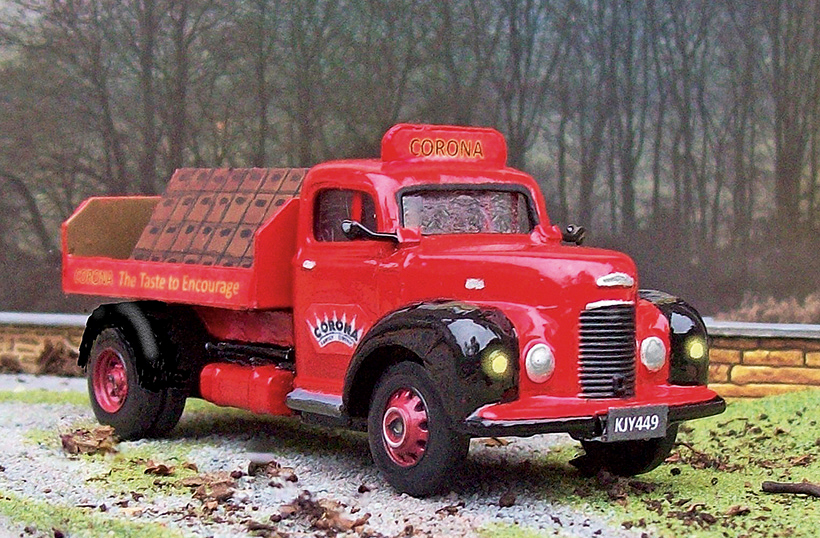
Commer Superpoise, KJY 449 (Plymouth, April 1955), is seen here with the light beginning to fade on a misty winter afternoon. The inspiration came from a reader’s letter in an old magazine. The writer was a driver for Corona Soft Drinks in the mid-1950s. My model started out as a 54-year-old Dinky Toys articulated lorry.
I’m very pleased with the way that the Corona Soft Drinks Commer Superpoise turned out, because it was a massive conversion job. It started out as a Dinky Toys No 424 Commer Articulated Truck (1963-1966). Incredibly, this chassis and cab casting first appeared in 1940 on the Dinky No 25X Commer Breakdown Lorry. In 1954, the breakdown lorry was re-issued as No 430. It continued in production until 1963, when some bright spark must have said: “I know, let’s stick a big, ugly trailer on it instead of the breakdown truck body and call it an artic, then we can get another three years out of it.”
Corona inspiration
My inspiration for the model came from a reader’s letter in an old magazine. Colin Barratt was a Corona delivery driver in the mid-1950s, based at the company’s Launceston depot, where it operated his Superpoise and two Morris-Commercials. My only reference picture was from Colin’s letter; I’ve never worked from a 50x40mm black and white photograph before but, try as I might, I couldn’t find another image of an early Superpoise in Corona livery.
The flatbed body with its load of crates, the new chassis rails and the cab’s headboard are all made from plastic card. I’ve given the model new wheels, seats and a driver, and finished it in Corona colours with lettering and logos made on my computer.
Who hasn’t been caught out, when a lovely summer afternoon in the park suddenly turned into a downpour? My photograph of the Ford Thames (Anglia) Walls Ice Cream van is intended to re-create just such a scene. It’s Corgi’s No 447, the one without ‘chimes’ – No 474 was the one with ‘chimes’, which I always thought were a bit pointless, but then I’m not six years old! The van was rough when I got it; the main problem being that half of the front bumper was missing. I rebuilt it with epoxy putty, repainted much of the bodywork and added a driver sheltering in his cab.
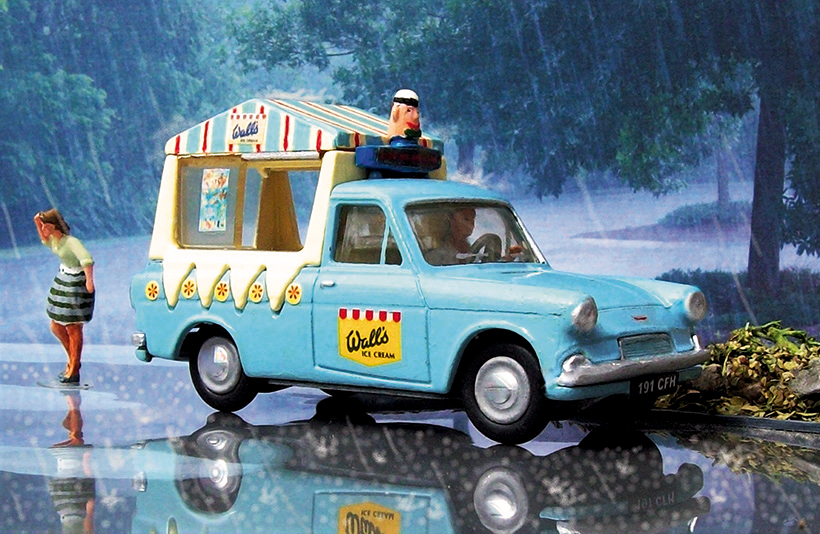
The Walls Ice Cream Ford Thames van, 191 CFH (Gloucester, March 1963), gets caught in a late summer downpour. That poor woman is going to be soaked, but don’t worry, she’s made of plastic! The model is by Corgi, although it’s not the one with the ‘chimes’, thank goodness!
I make no excuses for my choice of vehicle in the next photo, the 1958 Humber Hawk police car. I like big, old Humbers, and I like police vehicles. Can’t say I’m fond of driving after dark in heavy snow, though. The Humber is Dinky No 256 (1960-1964), and I’ve done very little to it except for detailing the interior, painting the chrome and adding number plates.

I thought I’d try to combine both snow and darkness in this image of a police Humber Hawk, 277 ARR (Nottingham, July 1958). The Humber is an old Dinky toy, with a lot of extra detail. I’m just glad that it’s not me driving as the roads look treacherous!
The Stanley Field AEC Regal, with Duple coachwork, is obviously one of Corgi’s collector’s items, although some extra detail, such as the chrome surrounds on the side flashes, and the aluminium trim strips on the lower body, have made it a bit more realistic. It’s pictured with one of Blackpool’s ‘Balloon’ trams No 713 next to the long-gone northbound waiting shelter at Talbot Square. I’m usually pretty successful when I research the vehicles I’m modelling but, this time, I’ve failed. I couldn’t find any information at all about Stanley Field coaches, except that they were based at Olive Lane, Blackheath, and that’s only because it says so on the back of the model!
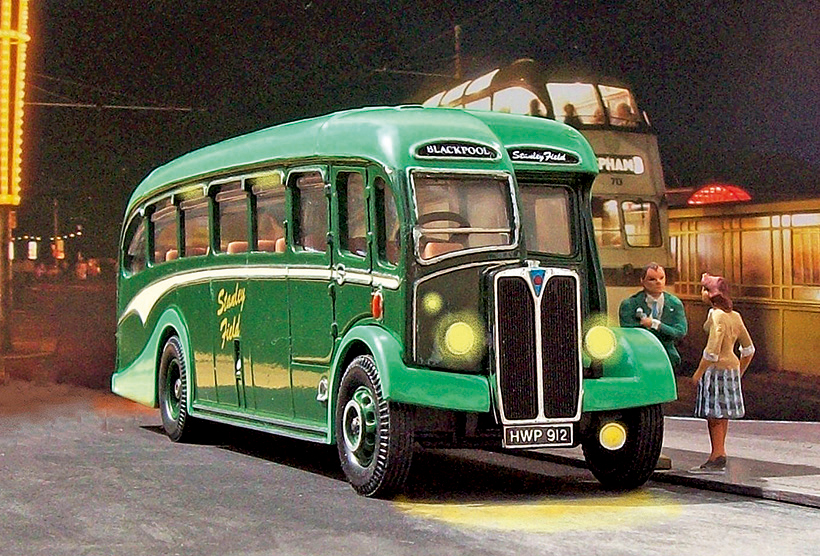
On a calm, mid-September evening, the driver of this AEC Regal coach HWP 912 (Worcester, September 1949), awaits the return of his passengers after a day trip to Blackpool. The ‘balloon’ tram in the background is Blackpool’s No 713.
My final photograph is of a 1971 Bedford CF van, Dinky’s No 410 (1972-1979), which I’ve re-worked from the AA service van toy. I’ve driven several CFs; they’re a nice van, but not as good as a Transit, in my opinion. Dinky made at least 30 different versions of No 410 in various liveries, the most bizarre of which was the Los Angeles Fire Department! What more can I say about this photograph, except that it’s a red van and it’s snowing?

“Wouldn’t you know it, Charlie? We buy a brand new van and, the following day, it bloomin’ well snows!” The Bedford CF van, HYW 141L (London, March 1971), was originally a Dinky Toys AA Service van, until I got my hands on it.
For a money-saving subscription to Vintage Roadscene magazine, simply click here



